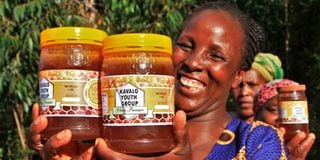Premium
When honey becomes poisonous

Members of Kavalo Youth Group with their honey for sale in Kitui County recently.
Honey, as a natural sweetener, food preservative, cosmetics ingredient and medicine is one of the most consumed foods worldwide.
However, once in a while, people report of becoming sick after consuming honey, which turns out to be poisonous.
Therefore, toxic honey poses an often ignored threat to the public. One such a case was reported on May 4 by the Daily Nation. The report said that in the last one year, at least nine people have died after reportedly consuming poisonous honey in Tharaka-Nithi County.
All the deaths were reported among the Tharaka, who practice traditional bee farming mainly to produce honey for domestic consumption or to prepare a traditional brew.
Although clinical signs of honey poisoning depend on the source of the poison, most signs range from the mad honey intoxication (being drunk and delirious) to vomiting, diarrhoea, stomachache, heart palpitations, headache and sometimes death.
Pre-disposing factors to unintended honey poisoning include presence of some rhododendron tree shrubs; formation of Hydroxymethylfurfural (HMF) chemicals during honey processing or preservation and consumption of raw (unprocessed honey).
Mad honey poisoning
Mad honey poisoning is induced by Grayanotoxin chemical, which is produced by a member of the Rhododendron genus of plants.
Normally, such honey is dark, reddish and has a bitter sharp taste, which irritates the throat thus the name bitter honey. There is no commercially available laboratory test for diagnosis of mad honey intoxication in the blood of the patient, but presence of Grayanotoxin in a honey sample can be detected through some tests.
Therefore, mad honey intoxication is diagnosed clinically when there is a history of honey consumption before the appearance of signs and symptoms that include dizziness, blurred vision, nausea, vomiting, headache, drunkenness and excess sweating.
Mad honey poisoning responds well to Atropine and normal saline treatment. In untreated cases, signs and symptoms of poisoning can be observed for a day but the recovery of the normal mental status is gradual and might take several days for the patient to fully recover.
In areas where Rhododendron plants are common, mad honey has been used positively in small doses to enhance male sexual performance, to treat hypertension, diabetes, ulcers, arthritis and other ailments.
Mad honey poisoning is not common in commercial honey due to the dilution factor of honey gathered from several sources for purposes of processing.
Control of mad honey poisoning is through abstaining from using such honey, and or consuming very small amounts, plus elimination of the Rhododendron plants. The plants are found in abundance in Kenya in the Aberdare area.
Formation of 5-Hydroxymethylfufural (HMF)
HMF is a chemical that is not naturally found in honey but may be formed during the heating or preservation processes after prolonged storage of the commodity. Apart from thermal treatment, other factors that favour formation of HMF include the specific sugars present in the honey such as glucose and fructose. HMF is associated with health problems that include cancer, and like in mad honey, HMF has been found to have positive health attributes that include antioxidants, anti-allergy, anti-inflammatory and others when used in small quantities. Low processing temperatures and short honey storage periods, are some of the factors that minimise the presence of HMF.
Consumption of raw honey
Unlike other food products such as milk and meat, which are high in moisture and low in acidity, conditions that are favourable for spoilage and or infectious bacterial multiplication, honey is low in humidity and high in acidity, thus reducing multiplication of pathogens and making it possible to consume it without further processing – heat treatment.
So when honey is pasteurised, it is for purposes of improving its colour, texture and to inhibit crystallisation.
Raw honey contains beneficial bacteria and nutrients, some of which are destroyed during pasteurisation. However, honey can also be contaminated with harmful bacteria such as Clostridium botulinum, which produces a toxin that causes botulism, a rare but serious illness especially in babies younger than a year-old.
This is because the digestive system of an infant has low oxygen and low acid. However, as the child starts eating solid foods, the digestive juices become too acidic and unfavourable for the bacteria multiplication.
Botulism in babies occurs three to 30 days after consumption of raw/contaminated honey and the initial signs of the condition include loss of facial expression due to paralysis of nerves and muscles of the face and head.
Poor sucking and feeding, difficulties in swallowing and breathing and general weakness (floppiness) and constipation are other signs. Treatment aims at neutralising the toxin and killing the bacteria. As a preventive measure, babies below the age of one year should not be fed honey or any processed food containing honey.
Dr Mwirigi is a livestock production specialist based in Nakuru. [email protected]





